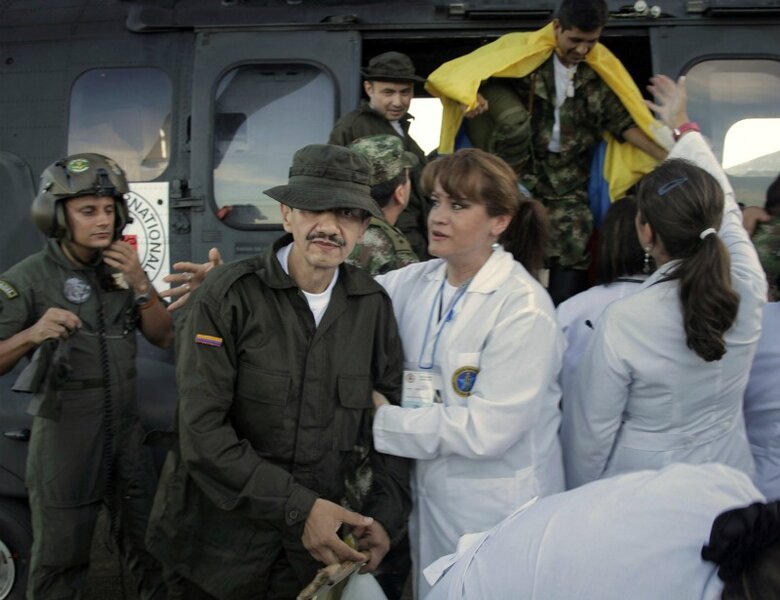FARC hostage release signals possible end to Colombia's internal conflict
Loading...
| Brussels
This week, one of Latin America’s oldest guerrilla organizations signaled the beginning of a possible end to Colombia’s half-century-old internal conflict – a fight that has involved those far beyond national and regional borders. (Colombia’s recent military campaign against the group was backed by more than $7 billion in aid from the United States.)
Yesterday, the Revolutionary Armed Forces of Colombia (FARC) delivered on its promise to free 10 military and police hostages it had held in the jungle for more than 12 years. FARC has also pledged to abandon its decades-long practice of kidnapping for ransom. (Hundreds of civilians have been held in captivity and scores have lost their lives. According to some organizations, several hundred more are still held captive for ransom.)
But these gestures might turn into the beginning of the end to decades of violent clashes in Colombia.
FARC was established in 1964 with a communist agenda, proclaiming to represent the rural poor against the Colombian state. The group finances its political and military struggle through kidnapping, extortion, illegal mining, and drugs – including control over cultivation, production, and trafficking.
Ending kidnapping altogether was one of President Juan Manuel Santos’s conditions for initiating talks with FARC. Tellingly, the group’s promise to refrain from kidnapping for ransom, and to release all remaining military and police hostages specifically, included a call for the government to start talks. Mr. Santos reacted with caution, and while there are many reasons to remain skeptical, the liberations should be seen as a first step and reason to move forward toward talks.
FARC is the weakest it has been for years, but it is far from being defeated. Its momentum was halted by former President Alvaro Uribe’s democratic security policy that targeted FARC leadership and restricted its areas of operation, though that military success was undermined to some extent by links between Colombia’s armed forces and illicit paramilitaries, and by human rights violations committed by the Colombian military.
FARC did not disappear, however: It returned to guerrilla-war tactics, adding victims daily through the use of explosives and anti-personnel mines. Communities in the country’s rural interior continue to suffer the reality of war; the humanitarian crisis is not over. In February alone, FARC attacks left over 25 dead and some 130 injured, most of them civilians. The ongoing confrontation continues to fuel displacement in a country that, according to some sources, has more internally displaced people than any other in the world.
After 50 years of fighting, it is clear that the war between the Colombian state and FARC is impossible to win on the battlefield. FARC fighters increasingly hide in isolated communities; constant attacks on military and police posts as well as land mine casualties wear out state forces; drug-trafficking, extortion, and illegal mining provide financial sustainability; and the weak state presence in many remote parts of the country enables insurgents to intimidate and dominate those communities.
After the traumatic failure of the Caguán peace process 10 years ago, Colombians harbor deep resentment toward any solution that appears to offer the FARC special political benefits. Conditions have changed, however. Today, the government operates from a position of strength that should give it greater control over any potential negotiations.
Over the past 18 months, important government initiatives have prepared the ground for peace by addressing root causes of the conflict. The Victims’ Law, surely the most important among them, plans to compensate some 4 million victims and hand back some 3 million hectares of stolen land. Further initiatives to offer economic opportunities, public services, and protection to communities in conflict-ridden areas and to reduce Colombia’s blatant social inequality will need to follow.
It is also clear why FARC should be ready to negotiate. The group has lost most of its legitimacy at home and abroad, and it thus has an interest in using its remaining muscle to negotiate before it fractures or otherwise weakens further. Kidnapping touches a central nerve of Colombian society, and this step could help improve FARC’s political standing.
FARC now has an opportunity to start dispelling widespread distrust by proving that it is willing and capable of delivering on its pledge. Now that the remaining military and police hostages have been freed, FARC should give a clear accounting of the large number of civilian captives still held for ransom and their condition, and ultimately liberate them as well.
Recognizing the liberations as an important first step, the government should consider further engagement once FARC has verifiably fulfilled its promise to stop kidnapping for ransom. Agreements binding the parties to International Humanitarian Law standards coupled with credible independent monitoring mechanisms, ultimately ensuring accountability for abuses, could help build confidence between the two parties and within Colombian society, and pave the way toward a peace process.
Domestic actors will necessarily have to be the main protagonists in reaching peace, but the international community needs to make clear that it stands by Colombians as the country readies itself to end one of the world’s oldest internal conflicts.
For the last few years, there has been a misleading perception that Colombia has entered a post-conflict phase, but ongoing fighting still affects the lives of millions and consumes a significant share of the country’s wealth. The current opportunity to bring this conflict to an end is too important to miss.
Louise Arbour is president of the International Crisis Group.





